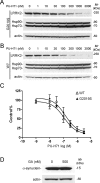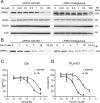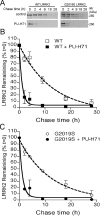The chaperone activity of heat shock protein 90 is critical for maintaining the stability of leucine-rich repeat kinase 2
- PMID: 18367605
- PMCID: PMC2564280
- DOI: 10.1523/JNEUROSCI.0185-08.2008
The chaperone activity of heat shock protein 90 is critical for maintaining the stability of leucine-rich repeat kinase 2
Abstract
Parkinson's disease (PD), a progressive neurodegenerative disease characterized by bradykinesia, rigidity, and resting tremor, is the most common neurodegenerative movement disorder. Although the majority of PD cases are sporadic, some are inherited, including those caused by leucine-rich repeat kinase 2 (LRRK2) mutations. The substitution of serine for glycine at position 2019 (G2019S) in the kinase domain of LRRK2 represents the most prevalent genetic mutation in both familial and apparently sporadic cases of PD. Because mutations in LRRK2 are likely associated with a toxic gain of function, destabilization of LRRK2 may be a novel way to limit its detrimental effects. Here we show that LRRK2 forms a complex with heat shock protein 90 (Hsp90) in vivo and that inhibition of Hsp90 disrupts the association of Hsp90 with LRRK2 and leads to proteasomal degradation of LRRK2. Hsp90 inhibitors may therefore limit the mutant LRRK2-elicited toxicity to neurons. As a proof of principle, we show that Hsp90 inhibitors rescue the axon growth retardation caused by overexpression of the LRRK2 G2019S mutation in neurons. Therefore, inhibition of LRRK2 kinase activity can be achieved by blocking Hsp90-mediated chaperone activity and Hsp90 inhibitors may serve as potential anti-PD drugs.
Figures







Similar articles
-
CHIP regulates leucine-rich repeat kinase-2 ubiquitination, degradation, and toxicity.Proc Natl Acad Sci U S A. 2009 Feb 24;106(8):2897-902. doi: 10.1073/pnas.0810123106. Epub 2009 Feb 5. Proc Natl Acad Sci U S A. 2009. PMID: 19196961 Free PMC article.
-
The G2385R variant of leucine-rich repeat kinase 2 associated with Parkinson's disease is a partial loss-of-function mutation.Biochem J. 2012 Aug 15;446(1):99-111. doi: 10.1042/BJ20120637. Biochem J. 2012. PMID: 22612223 Free PMC article.
-
Heat shock protein 90 modulates LRRK2 stability: potential implications for Parkinson's disease treatment.J Neurosci. 2008 Jul 2;28(27):6757-9. doi: 10.1523/JNEUROSCI.1870-08.2008. J Neurosci. 2008. PMID: 18596151 Free PMC article. No abstract available.
-
LRRK2 G2019S in the North African population: a review.Eur Neurol. 2010;63(6):321-5. doi: 10.1159/000279653. Epub 2010 Apr 23. Eur Neurol. 2010. PMID: 20413974 Review.
-
Leucine-rich repeat kinase 2 inhibitors: a patent review (2006 - 2011).Expert Opin Ther Pat. 2012 Dec;22(12):1415-26. doi: 10.1517/13543776.2012.729041. Epub 2012 Nov 6. Expert Opin Ther Pat. 2012. PMID: 23126385 Review.
Cited by
-
Progress in LRRK2-Associated Parkinson's Disease Animal Models.Front Neurosci. 2020 Jul 15;14:674. doi: 10.3389/fnins.2020.00674. eCollection 2020. Front Neurosci. 2020. PMID: 32765209 Free PMC article. Review.
-
Heat shock proteins: cellular and molecular mechanisms in the central nervous system.Prog Neurobiol. 2010 Oct;92(2):184-211. doi: 10.1016/j.pneurobio.2010.05.002. Epub 2010 Jun 4. Prog Neurobiol. 2010. PMID: 20685377 Free PMC article. Review.
-
Models for LRRK2-Linked Parkinsonism.Parkinsons Dis. 2011;2011:942412. doi: 10.4061/2011/942412. Epub 2011 Apr 7. Parkinsons Dis. 2011. PMID: 21603132 Free PMC article.
-
Quality control and fate determination of Hsp90 client proteins.Biochim Biophys Acta. 2012 Mar;1823(3):683-8. doi: 10.1016/j.bbamcr.2011.08.006. Epub 2011 Aug 16. Biochim Biophys Acta. 2012. PMID: 21871502 Free PMC article. Review.
-
14-3-3 binding maintains the Parkinson's associated kinase LRRK2 in an inactive state.Nat Commun. 2025 Aug 5;16(1):7226. doi: 10.1038/s41467-025-62337-1. Nat Commun. 2025. PMID: 40764514 Free PMC article.
References
-
- Auluck PK, Bonini NM. Pharmacological prevention of Parkinson disease in Drosophila. Nat Med. 2002;8:1185–1186. - PubMed
-
- Auluck PK, Meulener MC, Bonini NM. Mechanisms of suppression of α-synuclein neurotoxicity by geldanamycin in Drosophila. J Biol Chem. 2005;280:2873–2878. - PubMed
-
- Biskup S, Moore DJ, Celsi F, Higashi S, West AB, Andrabi SA, Kurkinen K, Yu SW, Savitt JM, Waldvogel HJ, Faull RL, Emson PC, Torp R, Ottersen OP, Dawson TM, Dawson VL. Localization of LRRK2 to membranous and vesicular structures in mammalian brain. Ann Neurol. 2006;60:557–569. - PubMed
-
- Bonifati V. Parkinson's disease: the LRRK2–G2019S mutation: opening a novel era in Parkinson's disease genetics. Eur J Hum Genet. 2006;14:1061–1062. - PubMed
Publication types
MeSH terms
Substances
Grants and funding
LinkOut - more resources
Full Text Sources
Other Literature Sources
Molecular Biology Databases
Research Materials
